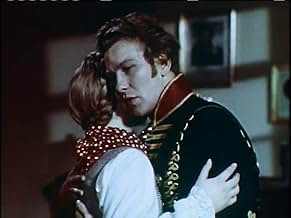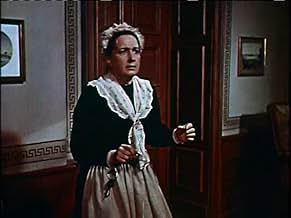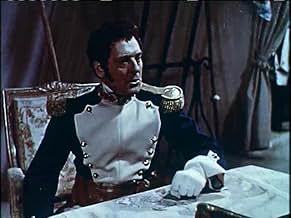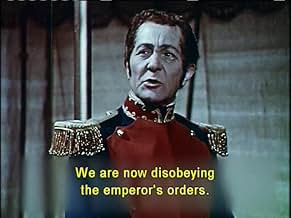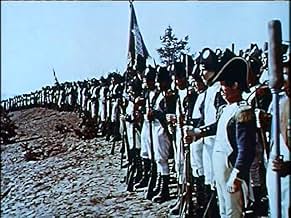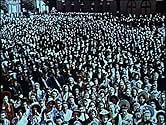Durante la campaña alemana de Napoleón, la ciudad de Kolberg queda aislada de las fuerzas prusianas. Los residentes organizan la resistencia contra el ejército francés que asedia y bombardea... Leer todoDurante la campaña alemana de Napoleón, la ciudad de Kolberg queda aislada de las fuerzas prusianas. Los residentes organizan la resistencia contra el ejército francés que asedia y bombardea la ciudad, negándose a rendirse.Durante la campaña alemana de Napoleón, la ciudad de Kolberg queda aislada de las fuerzas prusianas. Los residentes organizan la resistencia contra el ejército francés que asedia y bombardea la ciudad, negándose a rendirse.
- Dirección
- Guionistas
- Elenco
- Zaufke
- (as H.H. Schaufuss)
- Fanselow
- (as F. Schafheitlin)
- französischer Offizier
- (as St. Germain)
Opiniones destacadas
The film is set during the Napoleonic Wars--back around 1807. Town after Prussian town have surrendered to the oncoming French juggernaut. Yet, inexplicably, the town of Kolberg isn't ready to welcome the invaders. Despite a very weak commander of the Prussian army in the region, the Mayor isn't about to surrender and he's encouraging his people to fight to the death, as by slowing down the enemy, ultimate victory may result. But, he must contend with the wimpy commander and send a rather ordinary lady on a mission to have the King replace the commander and support the defense of the city. What follows are some exceptional battle scenes and the only ones which I have seen which are better are from the insanely large Russian version of "War and Peace" (a film you just have to see at least once in your life).
Overall, the film is very rousing and inspiring. It's obvious that the purpose of the film is to get the German people to be very willing to lay down their lives as well as convince them that this is not a sacrifice in vain (which is was). As a result, the film probably contributed to the unnecessary deaths of thousands of people--when there was no possible way to stop the inevitable. Plus, unlike the Prussians during the time of Napoleon, they were NOT fighting for what was right. Sad...but amazingly effective...provided the local movie houses had not been blown up so the folks could see it in the first place! By the way, the scene where the peasant girl meets the queen was exceptionally well done--even brilliant. See this and you'll understand what I mean.
Goebbels film studios managed to film and distribute this movie just as the final battles of World War II were being fought. Its message of defiant defense in the face of hopeless odds was meant to rally the severely demoralised Germans as their homes were being threatened by the enemy. The songs and vivid colours were meant to entertain and raise morale as life became darker and darker.
Technically, its a masterpiece, and makes use of all kinds of modern shots, angles, and special effects. Its colours were terrible, though, but I trust it was the copy I saw. Of course, it might have been a result of the war constraints.
Seen in this context, this film is even more interesting than the entertaining story it presents.
Jurched
That aside, 'Kolberg' is a marvellous piece of film-making. Beautifully shot in Agfacolor by Bruno Mondi with a powerful score by Norbert Schultze and intensely moving performances by some of Germany's finest.
The three leading characters of Gniesenau, Nettlebeck and Maria are basically symbols, respectively, of inspired military leadership, nationalist fervour and supreme sacrifice. Indeed, Gniesenaus' 'The people rise...the storm breaks' echos Goebbel's 'total war' speech from 1943.
Whatever one's feelings regarding demonised director Veit Harlan and the monstrous masters he served this film nonetheless remains an essential piece of cinematic history which no true cinephile can dismiss.
The story of the movie is not all that important... What matters is the great heinrich george, the rich colours, the hateful atmosphere of the movie - and the tragedy of reality as a background: Shortly after the making of "kolberg" was finished, germany was finished either:
The movie has a romantic perspective on a reactionary, aggressive, irrational and leader-oriented ideology... Not too far away from John Wayne, though I find him very entertaining as a green beret, either.
¿Sabías que…?
- TriviaFeatured 15,000 to 20,000 actual German troops in the battle scenes, even as Germany's eastern and western fronts were collapsing. The director tried to make the shooting longer to save them from being sent to the front.
- ErroresSaxony didn't separate itself from the Holy Roman Empire. It was separated after the Rheinbund was founded in 1806, to which Saxony was included later. Also, in the movie the inclusion of Saxony is mentioned by King Franz II. In real life it didn't happen until December, almost four months after Franz's resignation.
- Citas
Bürgermeister Nettelbeck: [after Gneisenau asks Nettelbeck to surrender] You weren't born in Kolberg, Gneisenau. You are put here to Kolberg. But we grew up here. We know every stone, every corner every house here. We don't let go. Even if we have to claw in the ground of our city with our nails, we don't let go. First they have to cut off each of our hands or kill us one after the other. Gneisenau, you can't put the whole disgrace on an old man like me. and to give our city to Napoleon. I even promised our king: rather be buried below the ruins that capitulate. Gneisenau, Gneisenau, I never stand on my knees for anyone, now i'm doing it: Kolberg can't be given up, Gneisenau!
Gen. Gneisenau: That's what I wanted to hear from you, Nettelbeck. Now we can die together.
- ConexionesEdited into Der 30. Januar 1945 (1965)
- Bandas sonorasEin Volk steht auf
Selecciones populares
- How long is Burning Hearts?Con tecnología de Alexa
Detalles
Taquilla
- Presupuesto
- DEM 8,800,000 (estimado)
- Tiempo de ejecución1 hora 51 minutos
- Mezcla de sonido
- Relación de aspecto
- 1.37 : 1
Contribuir a esta página


